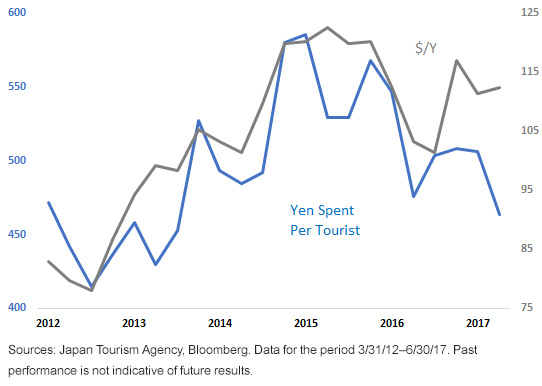Japan’s Tourism Boom to Bring Growing Political Support for Yen Depreciation


The boom in Japan’s inbound tourism is arguably the most tangible success story of Abenomics. Propelled by a steady stream of visa rule deregulation that started the first week that “Team Abe” moved into the prime minister’s office in December 2012, inbound tourist arrivals have risen almost fourfold, from a 2012 monthly average of 697,000 to 2.6 million recently.1 In terms of money spent, since 2012 the spending of inbound tourists has accounted for the equivalent of 16% of the growth in consumer spending (excluding spending on rent).2 Although the absolute amount of tourist spending is still small at less than 1.5%3 of all consumption, its exceptional growth rate has had a most positive impact on domestic Japan, with especially high positive multipliers for regional economies.
An important consequence of the success of Abe’s tourism strategy will be a break with a long-established exchange rate policy preference, in my view. While in the past, the policy establishment viewed yen depreciation as fundamentally negative for Japan because the resulting import-price cost push depressed further local business and regional economies, currency depreciation is now becoming viewed as a positive policy tool for driving domestic growth in general and regional growth in particular. From here, as the impact of the structural change that kick-started the tourism boom fades, the importance of the yen as a driver for inbound purchasing power is likely to rise. To keep tourism strong, Japan will need a weaker yen. All said, local political leaders—i.e., the backbone of the ruling Liberal Democratic Party—are likely to become more vocal advocates for yen depreciation, in my view.
From Structural Boost to Growing Foreign Exchange Sensitivity
Japan’s tourism strategy is arguably the most successful top-down regional growth policy implemented in an advanced economy. At first, Abe’s progressive deregulation of visa rules for Chinese and ASEAN tourists released structural pent-up demand—a new travel destination for Asia’s rising middle class. At the same time, the government pushed through supply-side deregulation (more airport landing slots, easier hotel building codes, etc.). The result: after decades of “hollowing out,” Japan’s regional economies are now rebuilding and reinventing themselves as tourist destinations. This is not because of one-off big-government spending programs but because of genuine private sector profit opportunities created by deregulation.
Team Abe deserves credit not only for kick-starting the cycle but also for seeking to anchor demand-growth expectations for private hospitality entrepreneurs by setting aggressive long-term goals: Japan wants 40 million visitors by 2020 and then 60 million by 2030, a massive jump from last year’s 24 million.4 These seem to make sense because of Asia’s population- and economic-growth dynamics.
However, there is no room for complacency: despite all the positive structural tailwinds, already the exchange rate plays an important role in determining Japan’s inbound tourism cycle. A strong yen immediately cuts the purchasing power of tourists, while a weak yen raises it. How much? Our analysis, shown in the graph below, suggests that yen appreciation cuts both visitor arrivals and average amount spent in Japan: 10 yen of yen appreciation appears to reduce monthly arrivals by approximately 1.2% and cut money spent per tourist by approximately 8%. While the impact on tourist volume appears negligible, the negative impact of money spent is significant. This has important negative implications for hospitality entrepreneurs for their price point and profit strategies.

Of course, from the perspective of a purist analyst, it is still too early for statistically sound conclusions on the exact factor contributions that are driving inbound tourist spending. The structural break forced by visa deregulation is still too recent—in fact, in early 2017 visa rules for Chinese nationals were eased further, and currency cycles have been relatively limited between 2012 and 2017. However, the fact that foreign exchange sensitivity already registers as a force of significant impact—despite powerful structural tailwinds still at work—suggests that, from here, the importance of the yen exchange rate as a key to the success of Japan’s inbound strategy will only grow.
Make no mistake: to keep the tourism boom growing, Japan needs a weaker yen. Japan’s policy advocacy for yen depreciation is poised to get stronger, in my view.
1Source: Japan National Tourism Organization.
2Sources: Japan Tourism Agency, Japan Cabinet Office.
3Sources: Japan Tourism Agency, Japan Cabinet Office.
4Source: Japan National Tourism Organization.
Important Risks Related to this Article
Investments focused in Japan increase the impact of events and developments associated with the region, which can adversely affect performance.


